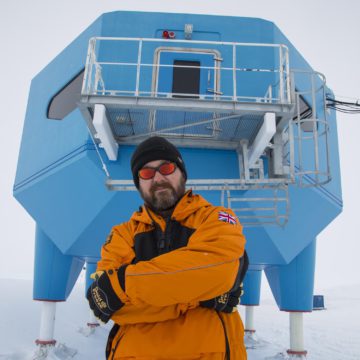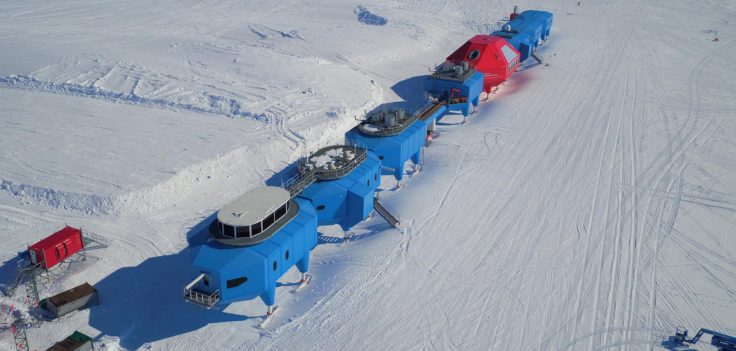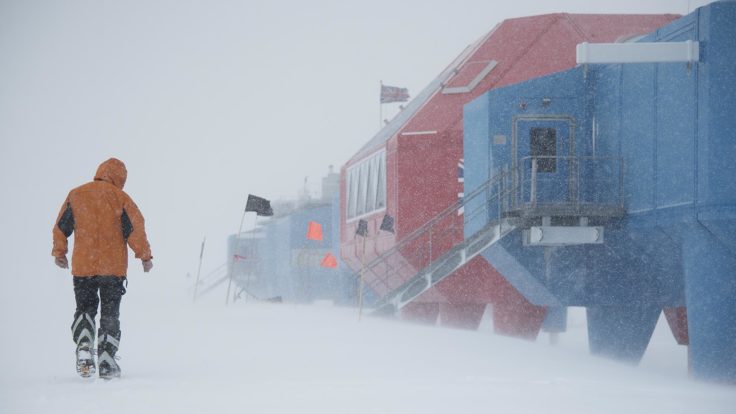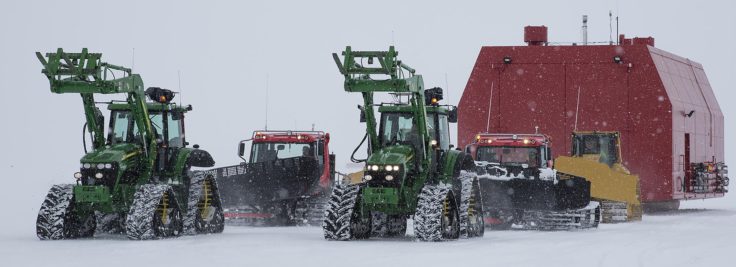Guest blog: How to move an Antarctic research station #1
3 March, 2017 Halley
This is Part 1 of a guest blog written by Ramboll engineer Ben Rowe, who was embedded with the British Antarctic Survey for 11 weeks to advise and assist with the challenging task of moving Halley VI 23 km upstream in order to avoid the path of a previously dormant ice chasm.

Sunday 11th December
This signpost outside the front of the modules is a stark reminder of just how far I am from the UK, 14255 kilometres to London.
We get in the habit of checking the weather. Primarily to see the impact of wind chill and sunshine to get a feel of the temperature, influencing how many layers of clothes are put on.
One aspect of working here is the continual dressing and undressing. Each building has a boot room by the main entry points where all our gear can be hung up and dried. With so many people these rooms are very busy, so you quickly learn to place your gear to ease both retrieval and avoid others picking up your kit.

Monday 12th December
Today I feel like I have arrived in Antarctica. Snow is being blown horizontally on the back of the 30mph wind. Overnight this has changed the fairly flat site around the temporary camp to ridges and troughs everywhere. When there is a deposit of fresh snow the contrast can become so uniform that you cannot see changes in the surface. A step forward and you can immediately trip or if still upright, find your-self waist high in powdery snow. With time you learn to anticipate where snow should have been deposited – which is usually long tails going from high and wide to low and narrow from east to west.
Today we hoped to carry out bolt adjustments and then lower the H2 module ready for towing tomorrow. I spent some time using energy calculations taking me back to A level physics to work out the theoretical stopping distance of the module, which with slope adjustment gave me a value around 150mm.
Due to the continuation of the poor weather it makes everything take so much longer and increases the risk of errors and potential of injuries, so the decision is taken to not battle for small gains today.

Tuesday 13th December
The awful weather continues today; the move of the first module will not happen today for sure. I spent some time looking at stability scenarios if the hydraulics in a leg failed and the rapid shortening created a loss of support. The risk of a sudden leg failure could lead to instability that could damage both the building services and the Trelleborg (the flexible rubber connection between modules) at the interface with the adjacent module.
In this event one or more modules could become uninhabitable. Preparedness is so important here to ensure that we can cope with unexpected situations. It’s one thing tackling this sort of work in the summer season, and entirely another trying to do so in the harsh winter conditions.
Thursday 15th December
It’s another snowy and windy day. Lots of snow tails complicating movement between modules and other buildings.
We tested straps for the bridge lift and checked these could be fed through the gap between the steelwork and the cladding. We also checked the steelwork to check the bridge will fit onto the temporary steelwork frames and skis that were fabricated in the UK many months ago in preparation for this and sent with the relief ship.
I carried out some more work on the restraint forces on the bridge beams combined with forces needed to resolve any eccentricity during the lift. We also discussed the sequence of installation at the new Halley VI site, called site VIA. The E1, bridge and E2 modules (generators and plant module) are likely to be the most complex and sequentially difficult aspect of the installation. H1 and H2 and also the other modules can then be dragged to align with the energy modules. This also allows the mechanical and electrical team to progress with the most intensive part of their work which will help the overall programme.
Today the mechanic’s garage and annexe were moved to the new site VIa- all went well.
